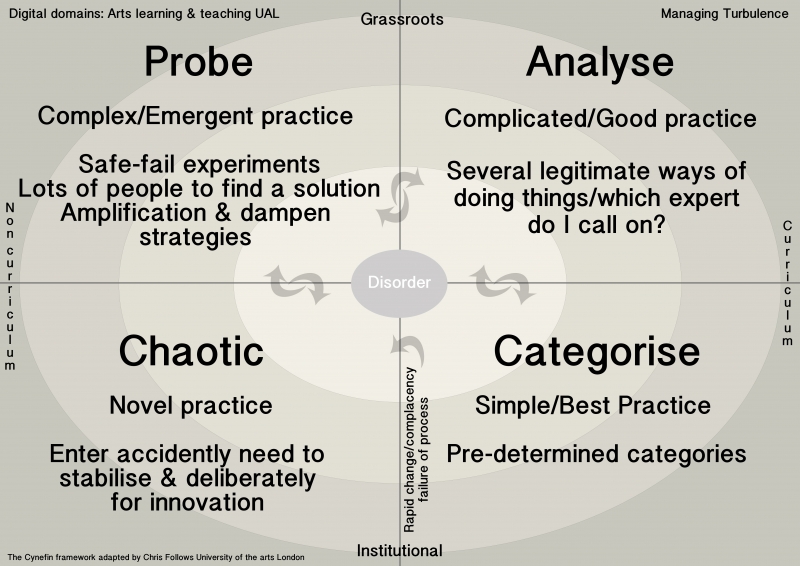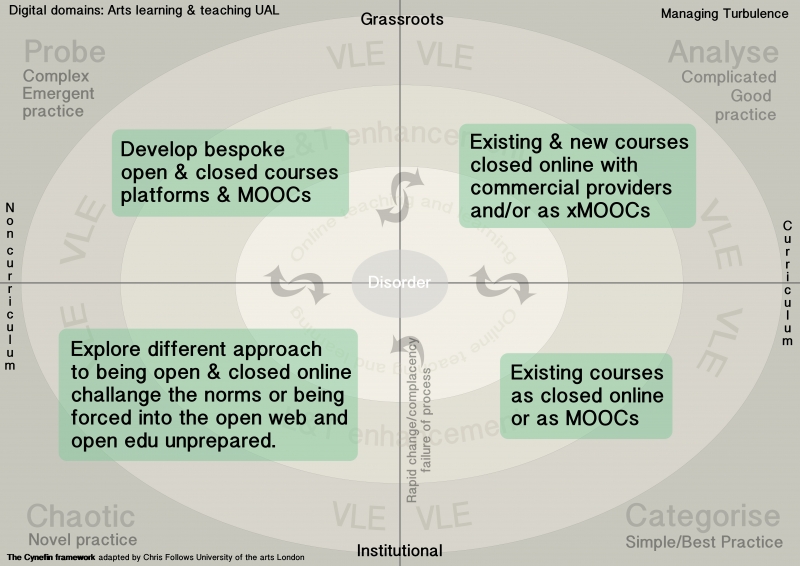Understanding digital domains in arts learning & teaching
The virtual learning environment (VLE) at University of the arts London (UAL) is quickly becoming an accepted norm for delivering the UAL online L&T experience, best practice examples provide clear and simple pathways for those using & embedding digital tools in L&T. Conversely the institutionally managed VLE can be seen as constraining or inadequate in meeting the needs of some individuals & courses (read more about this here).
How do we reconcile these differences?
Making sense of the current digital L&T landscape is complicated, there are so many different factors involved, clearly there's more to L&T then the institutional managed tools and spaces. To help illustrate and explore the different perspectives across the agile landscape of digital L&T at Camberwell, Chelsea & Wimbledon (CCW) colleges of arts, (departmental, student, staff, discipline, course, programme, college and the sector) I have adapted the cynefin sense-making framework.
Below are four domains of the Cynefin framework: Simple, Complicated, Complex and Novel, we move between these domains as we situate and understand digital L&T practice. If we don't know which domain we belong (disorder) we need to decide what action is best appropriate to apply to the situation to move forwards: Categorise, Analyse, Probe or Stabalise. I have added opposites on each side of the framework to help highlight the differences between grassroots & institutional approaches and in curriculum and non curriculum dependencies.
The ideal domains to operate are within the top two quadrants, complex & complicated domains, although we should operate within the simple/best practice if we have good reason to apply 'best practice', we should resist applying too many constraints or becoming too complacent within the simple/best practice domain when applying best practice.

Managing turbulence and understanding digital domains in arts learning & teaching
CCW Baseline:
Based on previous experience and conversations with staff and students over the past few months I've identified a baseline/starting point in which to help understand and base future discussions around what we mean by digital learning and teaching enhancement, the CCW baseline list includes:
UAL digital tools, services & processes:
- VLE feedback: Students & staff
- VLE support: CCW approaches to IT VLE & TEL support & change management
- Guidance & terms of reference: Resources & documentation - does CCW need a VLE Strategy?
- Communication: Explore cross college, course, departmental communication.
Digital learning & teaching enhancement:
- Staff development: Joined up approach in delivery of IT/TEL training formal & informal
- Manage change: Support integration of new software & hardware changes & new policies or processes
- Innovation & experimentation of digital L&T (hardware, software and changes in L&T practice& curriculum)
- Digital L&T spaces: support curriculum integration & improvement of digital technical & academic spaces, resources & support.
Online learning and teaching and curriculum enhancement:
- Blended learning: approaches & benefits realisation
- Part & fully online curriculum development(open & closed): Discussions, pilot projects & low risk experimentation around the concepts & issues.
- Sector/tech industry partnerships& collaborations in online learning: Online tool & environment design & development.
Using the above list we could see the three areas as being located in following domains in general terms:
 |
Simple - VLE, tools & services: constrained & supports best practice but possible complacency. Complicated - L&T enhancement: support several different ways of doing things, expertise required in specific areas of practice. Complex/Novel – Online learning: Where emergent practice takes place, safe-fail experiments. |
In the below illustration I’ve included a radius of three areas VLE, L&T enhancement and Online learning to help highlight our current position as well as the potential to move between the different domains we may inhabit.
How the current landscape may look:

How this may apply to the online learning landscape:

How do we support complicated and emergent learning and teaching practice in HE?
The Cynefin framework does a great job of helping us identify gaps in the agile landscape, but equally important it helps us appreciate and accept all the different domains of digital L&T practice that work well.
The mapping process clearly highlights the imbalance between (safe/simple) curriculum dependent/institutionally led and supported TEL (technology enhanced learning) and grassroots (complicated/complex) influenced TEL, an issue I aim to highlight and explore over the next few months.
Also see: Online learning at Camberwell Chelsea & Wimbledon Colleges of Art (CCW)
http://process.arts.ac.uk/content/online-learning-camberwell-chelsea-wimbledon-colleges-art-ccw
Digital Learning Technologies Manager
CCW Learning and Teaching Enhancement (LTE)
University of the Arts London
Twitter: @CCWPostDigital

This Work, Understanding digital domains in arts learning & teaching, by cfollows is licensed under a Creative Commons Attribution-ShareAlike 4.0 International license.

